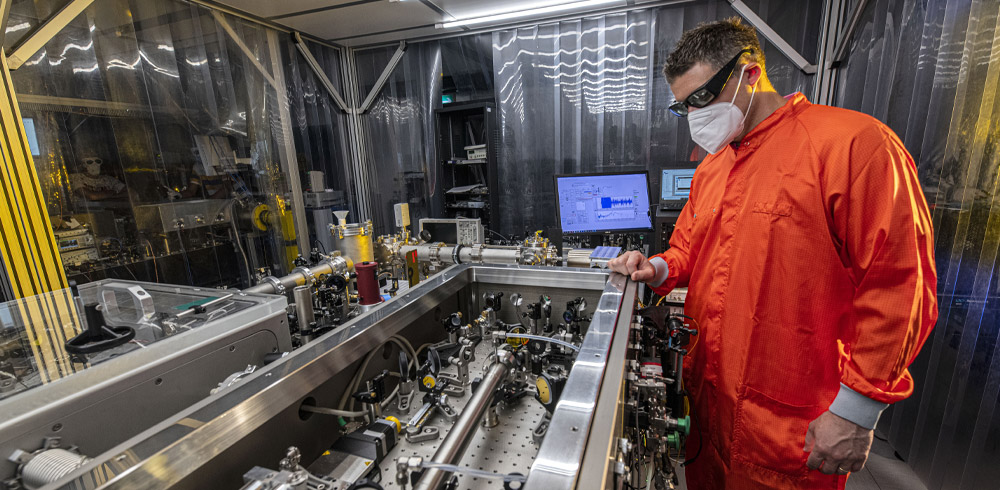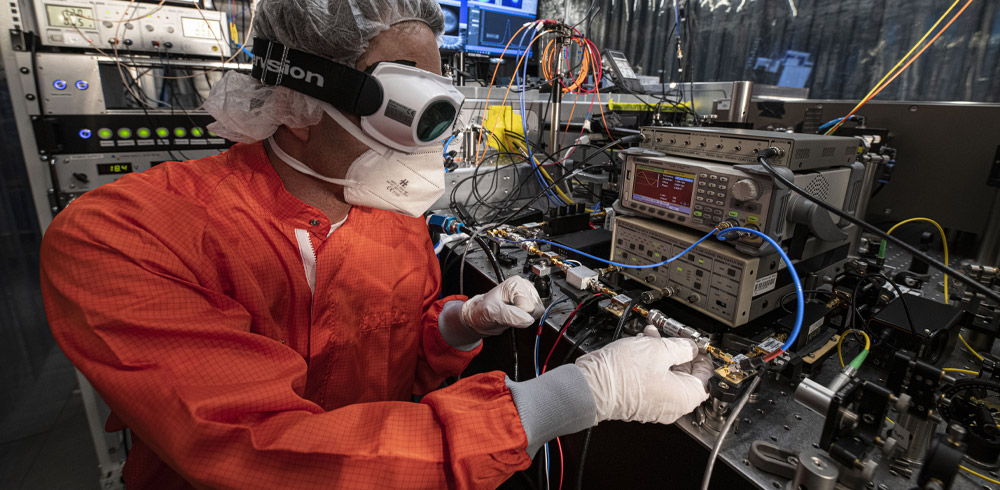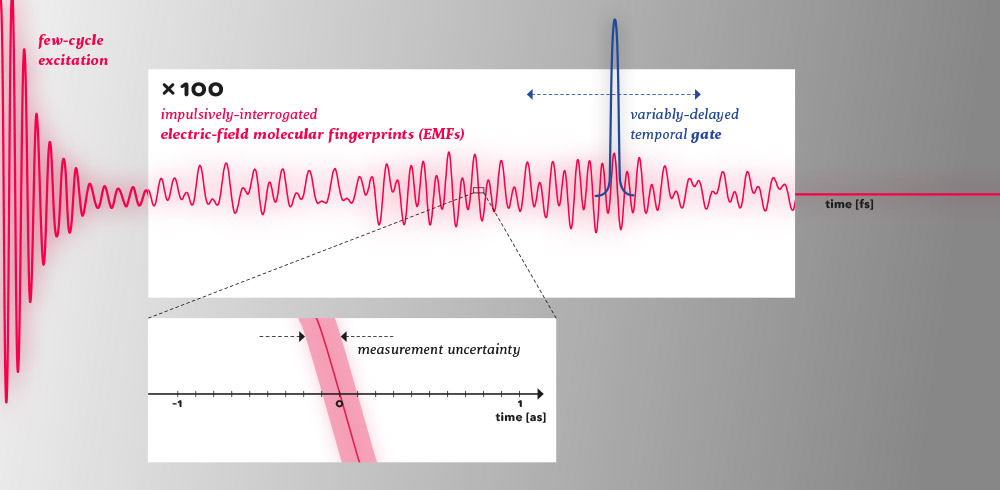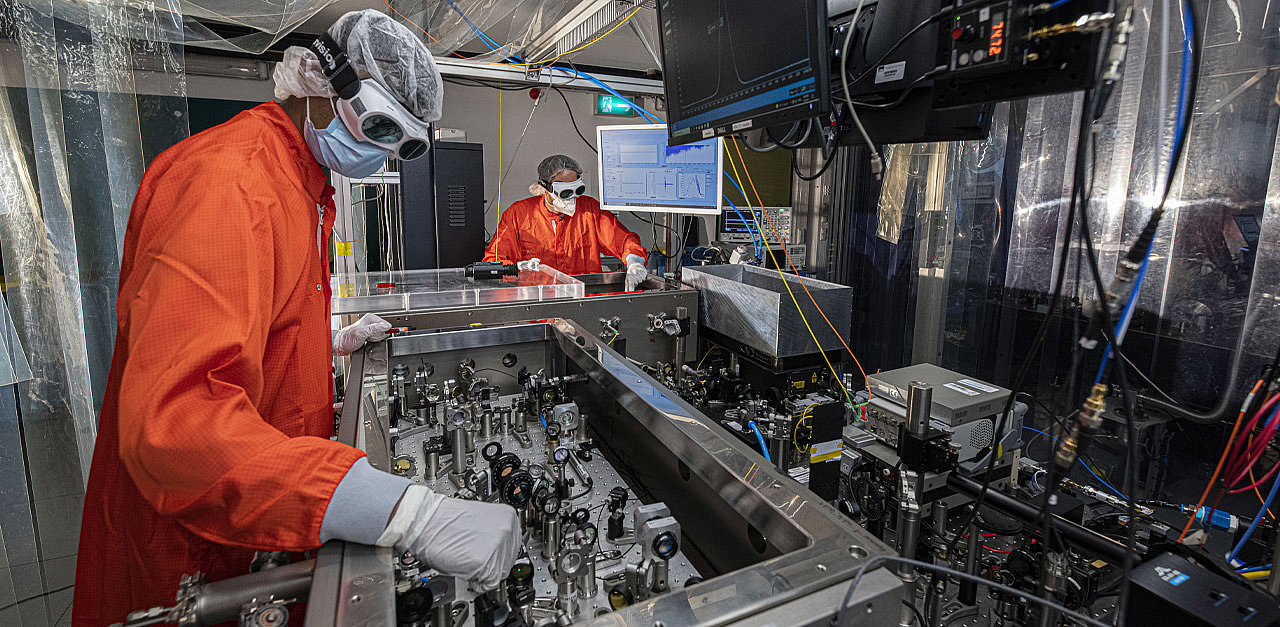Researchers at Attoworld are exploring novel routes to reach the ultimate limits of broadband infrared spectroscopy. These developments grant deeper insight into light-matter interactions, advancing our understanding of fundamental processes in nature, and spawn spectroscopic technologies that expedite the early detection of diseases via quantitative, multivariate molecular probing of biological samples.
The origins of the term spectroscopy can be traced back to the second half of the 17th century, when Sir Isaac Newton observed that a prism can disperse sunrays into a spectrum of beams with different colors. The common perception that optical spectroscopy evaluates color- or (frequency-)specific intensities in a static (that is, time-averaged) manner, prevailed for three centuries – until several decades ago, when laser modelocking provided a new means of confining broad optical spectra to ultrashort flashes of light. Nowadays, modelocked oscillators routinely produce femtosecond pulses throughout the visible and near-infrared spectral ranges. Their brevity makes it possible to trace ultrafast phenomena in matter as they unfold on their native time scales, such as (bio-)chemical reactions or lattice dynamics in solids.
While the mechanisms of laser modelocking ensure a recurring temporal intensity envelope of ultrashort pulses, the most sophisticated degree of control over light came about in the 1990s with the additional ability to control the timing of the individual oscillations of the optical electric field with respect to its intensity envelope. This, in turn, allows the manipulation of dynamics in matter which are intimately linked to the electric field of light via (susceptible) local charge distribution. Thanks to their outstanding temporal coherence properties, femtosecond-laser architectures based on optical-phase-stabilized pulses derived from modelocked lasers have revolutionized our perception of spectroscopy and provide real-time access to the oscillatory nature of light.
At Attoworld, the generation, measurement and application of intense optical pulses as short, or shorter than, a single oscillation of the electric field has a long tradition. In recent years, research has focused on high-sensitivity electric-field-resolved spectroscopy (FRS) in the infrared (IR) spectral region. In biological molecules – which constitute the building blocks of life – the interaction with light in this spectral range induces characteristic internal vibrations with a particularly high efficiency. In contrast to other analytical techniques, broadband vibrational spectroscopy delivers a signal consisting of coherent contributions from all constituent molecular vibrations, thus forming a sample fingerprint that is highly specific and sensitive to minuscule changes of the sample composition.
Teams affiliated with three institutions forming the Attoworld are closely working together to develop IR spectroscopy toward the fundamental limitations set by the nature of light. These emerging spectroscopic tools are advancing our understanding of fundamental physical processes, as well as the realization of the vision of establishing molecular vibrational fingerprinting as a standard, high-throughput screening technique for health monitoring and early disease diagnostics.
Impulsively exciting molecular vibrations
The temporal confinement of broadband IR radiation to pulses comprising merely a few oscillations of the electric field of light lends itself to the impulsive excitation of molecular vibrations in complex samples, see also Fig. 1. For the brief time span of the excitation pulse, the oscillating electric field of light modulates the inter-atomic distances in the sample by acting on the molecular electric dipole moments. In the wake of the few-cycle excitation, the molecular vibrations continue, each vibrating dipole emitting radiation at its specific frequency. The contributions of molecular vibrations of the same type add up coherently, forming a highly-specific sample response to the ultrashort excitation. Exciting the molecular vibrations with a short pulse allows to separate the coherently emitted long-living sample response from the excitation. This differs from time-integrating spectroscopies, such as Fourier-transform spectroscopy, in that the excitation impinges on the detectors only during a comparatively ultrashort portion of the sample response. Important advantages of FRS regarding robustness against excitation noise (filtered out by the aforementioned temporal separation) and an increased range of detectable concentrations were recently demonstrated with our 1st-generation instrument (Pupeza et al., Nature 2020). The requirement of an ultrashort, fast-decaying excitation is tantamount to a broad bandwidth of the excitation. In turn, the latter provides access to a wide range of molecular vibrations. Thus, both the time-domain and the frequency-domain aspects of FRS set the course for developing waveform-stable IR sources with as broadband and short pulses as possible. While the 1ˢt-generation instrument covered only ~10% of the IR spectral region relevant for vibrational fingerprinting, recent developments at Attoworld, employing 2-µm femtosecond frontends, have demonstrated the feasibility of covering the entire spectral range of interest with single-cycle pulses.
The time-domain character of molecular fingerprinting with FRS both requires and affords a new perspective on the concept of molecular fingerprints. Scientists at Attoworld are currently developing standardized protocols for recording impulsively-interrogated electric-field molecular fingerprints (EMFs), based on the basic concept of causality (invited paper, in preparation for Nature Protocols).
 FRS in the gas phase. The excellent sensitivity of FRS enabled limits of detection in the ppb range at an interaction length of only 45 cm. The gas cell is the metal tube visible on the picture. Picture: Thorsten Naeser
FRS in the gas phase. The excellent sensitivity of FRS enabled limits of detection in the ppb range at an interaction length of only 45 cm. The gas cell is the metal tube visible on the picture. Picture: Thorsten Naeser
Optical waveforms with zeptosecond reproducibility
The first key ingredient for recording high-quality EMFs of (complex) molecular samples is the reproducibility of the optical waveform exciting the molecular vibrations. Employing lowest-order (that is, most efficient) nonlinear processes both for the generation of optical-phase-stable IR pulses and for the detection of their fields, our team has recently demonstrated optical waveforms with world-record reproducibility. In a measurement time of ~1 minute, the individual zero crossings of these waveforms can be located in time with a precision of roughly 100 zeptoseconds, see also Fig. 1. For comparison, this is more than a thousand times less than the 150 attoseconds it takes for an electron to orbit around a proton according to Bohr’s model of the hydrogen atom.
Numerical modeling performed in our team traced this residual jitter back to the technical noise of our 1ˢt-generation modelocked laser. Recent developments of our 2nd-generation femtosecond frontends, based on Cr:ZnS 2-µm modelocked oscillators, have provided output pulses exhibiting tantalizingly low noise. If this can be further lowered towards the shot-noise limit inherent to the photon nature of light, it could improve IR waveform stability toward the fundamental physical limit and enable FRS with single-digit-zeptosecond precision.
Careful listening to molecular vibrations
The electric field of light emanating from a molecular sample upon a waveform-stable, impulsive excitation, entails the full macroscopic information content acquirable via linear optical spectroscopy. However, its detection on the level of the individual electric-field oscillations is challenging because IR light oscillates about a thousand times faster (~10 femtoseconds) than the fastest electronics (~10 picoseconds). Sampling these optical waves fundamentally requires a shorter event, constituting a temporal gate, through which only a fraction of the stream of photons making up the entire EMF can enter toward the detector, see blue pulse in Fig. 1.
 Precision time-domain measurements require advanced optical and electronic techniques. With those, we performed – for the first time – IR spectroscopy with two separate modelocked oscillators, with sub-attosecond precision. Picture: Thorsten Naeser
Precision time-domain measurements require advanced optical and electronic techniques. With those, we performed – for the first time – IR spectroscopy with two separate modelocked oscillators, with sub-attosecond precision. Picture: Thorsten Naeser
Once more, the confinement of light to very short flashes provides the key ingredient. The gating mechanism we employ relies on an optical nonlinear mixing process in which the IR wave to be sampled interacts with the gate flash within a nonlinear crystal. Such nonlinear effects inherently bring about a bandwidth-versus-efficiency trade-off, and require high intensities. The latter, in turn, are limited by damage in the nonlinear medium.
In collaborations with Prof. Alfred Leitenstorfer at the University of Konstanz and Prof. Jens Limpert at the University of Jena, world-leading experts in fiber lasers, we have devised a new regime for optical-field sampling, employing short-wave mid-IR pulses as short as 10 fs to sample octave-spanning EMF waves with an efficiency exceeding 1% of all the photons. Expressed in terms of molecular concentration – which scales with the electric field strength – the demonstrated detection sensitivity is merely 10 times away from the ultimate quantum limit. This sensitivity exceeds by far that of previous optical-field sampling techniques and, together with the record average powers of our 2nd-generation IR sources, they provide quantitative access to unprecedently large molecular concentration ranges.
Molecular fingerprinting with unprecedented sensitivity and detectable range of concentrations
In a first proof-of-principle with a 2ⁿd-generation FRS instrument benefitting from record-high excitation powers and electric-field detection efficiency, we have recently demonstrated the capability of quantitatively recording EMFs from multi-species gas-phase samples spanning a concentration range of close to 8 orders of magnitude. Notably, this performance was achieved with a broadband IR coverage of more than an octave, and at a sample interaction pathlength of only 45 cm. With pathlength enhancement technologies such as multi-pass cells or enhancement cavities, the detection of concentrations spanning 10 orders of magnitude seems within reach.
In terms of detection sensitivity and accessible concentration range, these performance parameters vastly exceed the capabilities of other devices – such as time-integrating optical spectrometers and gas chromatography-mass spectrometry – for the simultaneous detection of multiple species. In addition, they point to the capability of FRS to – in principle – record molecular signals over the entire physiologically-relevant concentration range of molecules in biological samples.
While these proofs of principle attest to the conceptual feasibility of IR spectroscopy with FRS close to the ultimate limits set by the quantum nature of light, our prototypical instruments are rather bulky and expensive. Scientists in the CMF team are working on the next generation of FRS instruments based on the Cr:ZnS femtosecond technology developed at Attoworld, with the aim of combining the spectral coverage of the entire molecular fingerprint region with close-to quantum-limited EMF detection sensitivity, in compact, robust and cost-efficient instruments.
 Figure 1: A few-cycle IR pulse excites molecular oscillations in a sample. Upon excitation, these emit a sample-specific response, the “EMF”. This signal is recorded via nonlinear mixing of the EMF with a 10-fs-scale gate pulse. The inset illustrates our current measurement uncertainty for individual zero crossings of the EMF, which is on the order of 100 zeptoseconds. Graphic: Dennis J. K. H. Luck
Figure 1: A few-cycle IR pulse excites molecular oscillations in a sample. Upon excitation, these emit a sample-specific response, the “EMF”. This signal is recorded via nonlinear mixing of the EMF with a 10-fs-scale gate pulse. The inset illustrates our current measurement uncertainty for individual zero crossings of the EMF, which is on the order of 100 zeptoseconds. Graphic: Dennis J. K. H. Luck
